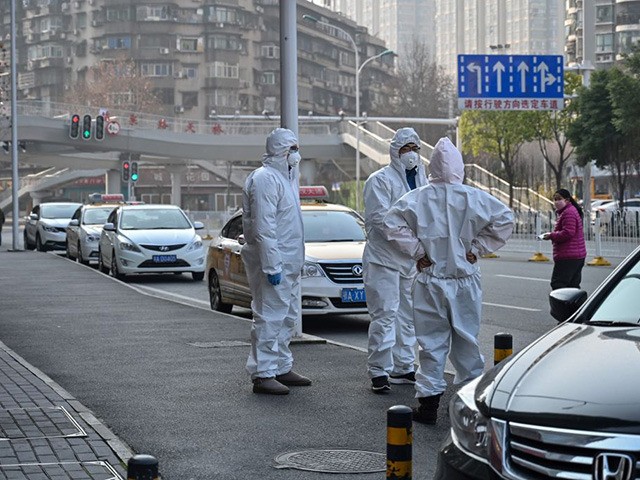China’s Global Times government newspaper published a column Monday celebrating the virtues of the Communist Party, applauding the “Party system” for Beijing’s response to the growing coronavirus outbreak within its borders.
The Chinese communist regime alerted the world to the discovery of a never-before-seen type of coronavirus originating in the central regional capital of Wuhan on January 20. Chinese officials alerted the World Health Organization (WHO) of a burgeoning outbreak, however, on December 31, and shut down a wild meat market in Wuhan suspected of being the origin of the outbreak a day later, failing to warn health workers or Wuhan residents to take protective measures against a highly contagious disease.
China’s secrecy, inability to contain the virus, and failure to cooperate with the American Centers for Disease Control (CDC) on virus response have triggered global outrage.
As of Tuesday, the virus — which can trigger deadly pneumonia — has killed nearly 500 people worldwide, all but two within China, and infected over 20,000 people.
The Global Times celebrated the Communist Party as an ideal vehicle in public health crisis response in its column Monday, calling the coronavirus outbreak a “chance for the outside world to observe the Chinese system.”
“The epidemic is still spreading and the situation is still very grim. To really prevent and control the epidemic, we need to focus on every community and household. In this process, primary-level Party organizations can play an essential role,” the Times suggested. “Whether we can resist the attack of the epidemic to a large extent depends on the work of these organizations.”
The article, titled “Response to Virus Shows Strength of Party System,” applauded the Communist Party for having mobilized and its local cells for having “formed an effective network to fight the epidemic. For instance, people who come out of the city of Wuhan after the outbreak can be quickly traced and located. These organizations have adopted quite strict quarantine measures to block the input of infectious patients, reducing the risk of local epidemic transmission.”
The Party, in other words, is using its extensive surveillance infrastructure — more commonly used to silence and imprison dissidents — to track potential virus carriers. Similarly, the Global Times portrays the Party’s propaganda mechanisms as beneficial to public health, as local officials in Inner Mongolia “have made many Putonghua [Mandarin]-Mongolian bilingual short videos” about the virus.
The Global Times admitted it is almost entirely unclear if these communist efforts have done anything beneficial for the country, but praised them anyway.
“It is not yet time to say exactly what role primary-level Party organizations have played in the current fight against the epidemic. However, this may be a good chance for some foreigners and foreign media to learn more about China,” the newspaper suggested. “As China is fighting the epidemic, some Western media are badmouthing and blackening the Chinese system. We hope that they can see the efficient operations of China’s primary-level Party organizations.”
The state newspaper notably omits in its description of the Communist Party as a force for good against the viral outbreak the mounting evidence that the Party and its leader, dictator Xi Jinping, actively conspired to suppress the true number of coronavirus carriers and neglected to properly shut down at-risk events and locations in Wuhan in a timely manner. Reports from within Wuhan suggested in late January that locals were aware of a viral infection spreading as early as mid-December, but had no information regarding it, especially the key detail that the virus causing it was a newly identified one. Health workers have anonymously denounced Wuhan officials for not making them aware, which led to hospitals believing there was no reason to quarantine or otherwise isolate patients with the telltale flu-like symptoms of the new coronavirus. As the virus is now believed to be highly contagious through moisture particles in the area, dozens of health workers and hospital patients are believed to have been infected needlessly due to lack of isolation.
Once the Chinese government began moving to contain the virus, reports indicated that it was deliberately limiting access to testing kits. Individuals with fevers, coughs, or other potential coronavirus symptoms reported being turned away from hospitals; only patients approved by the Communist Party were allowed to be tested for coronavirus, suggesting that dozens, if not hundreds, of virus carriers were never tested and thus never formed part of the official case tally.
The rejection of patients at Wuhan hospitals spawned widespread public outrage, perhaps most dramatically illustrated by video published by the South China Morning Post of a man with a fever, rejected for coronavirus testing, coughing in the face of health workers in revenge.
Last week, China’s National Health Commission claimed that the number of new cases of the virus per day was declining, suggesting that the outbreak had peaked despite academic and medical experts stating it would take months for the virus to start spreading more slowly. At the time, the Chinese government and the World Health Organization claimed that 6,061 cases of the virus had been documented and 132 people had died.
Today, that number stands at 20,676 cases of confirmed coronavirus infection and 427 deaths, only two of which occurred outside of China (one in the Philippines and one in Hong Kong).

COMMENTS
Please let us know if you're having issues with commenting.